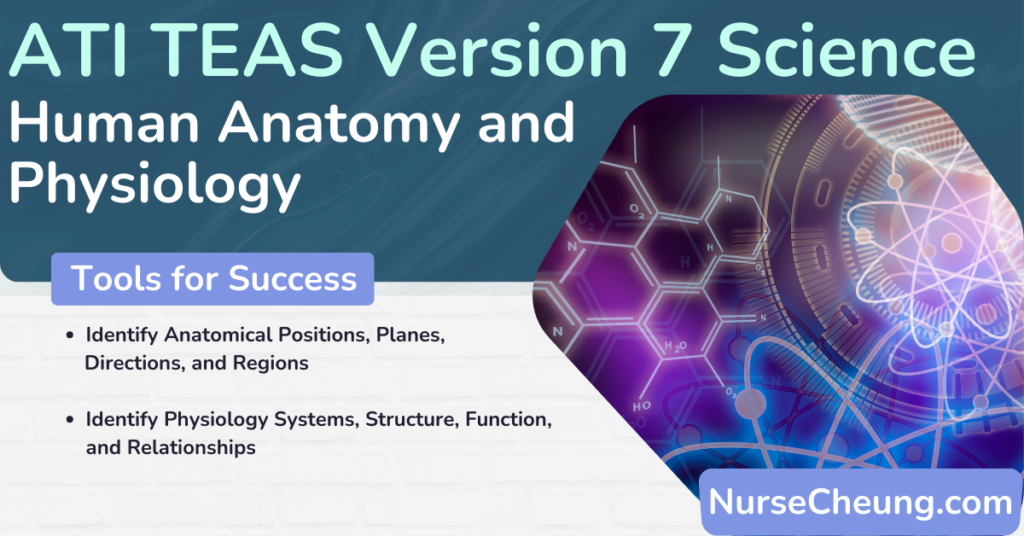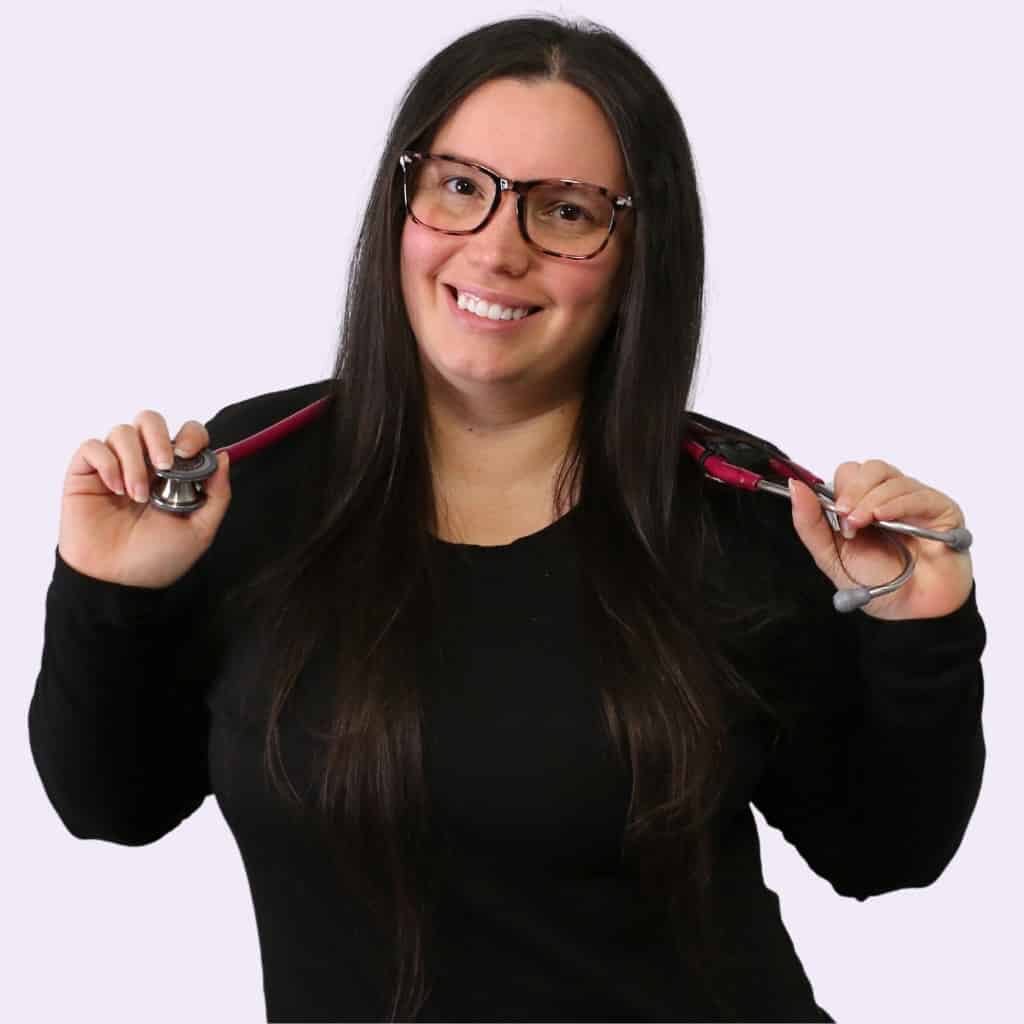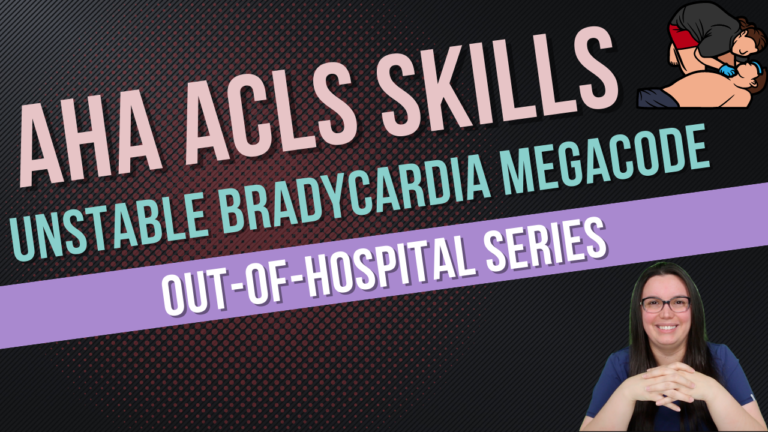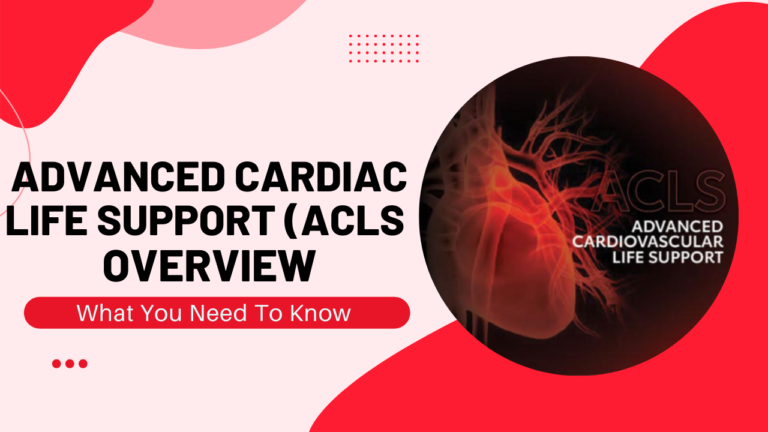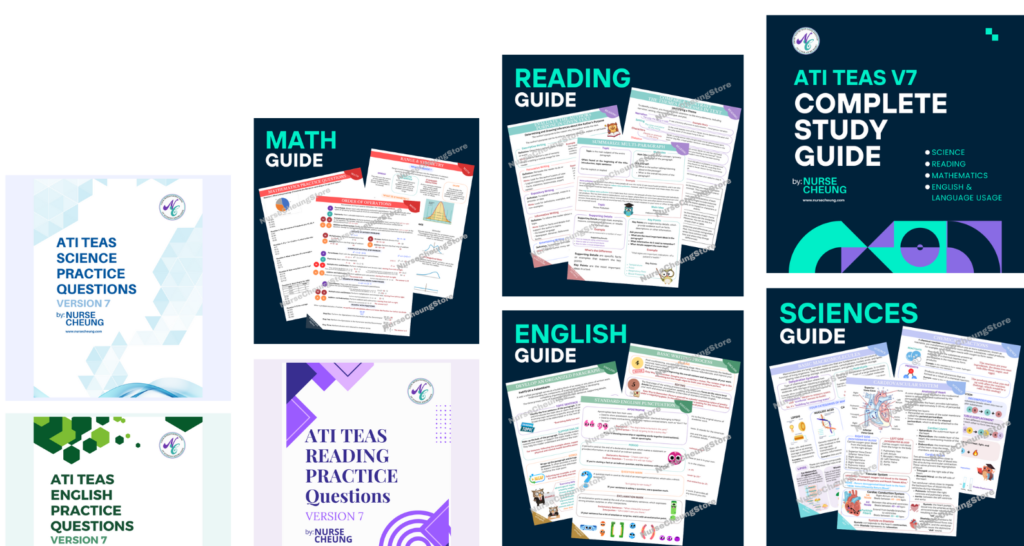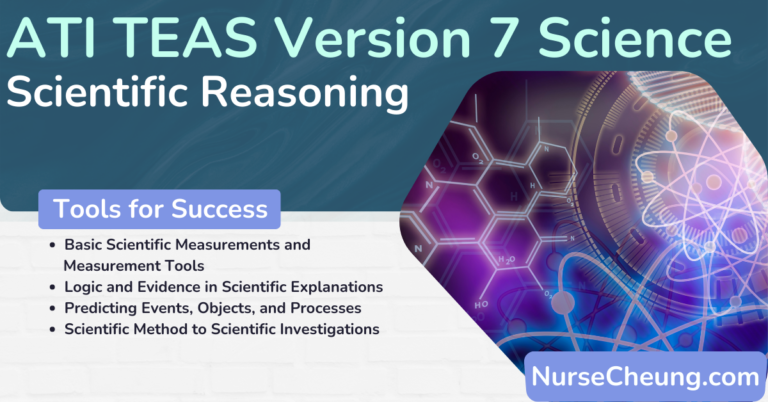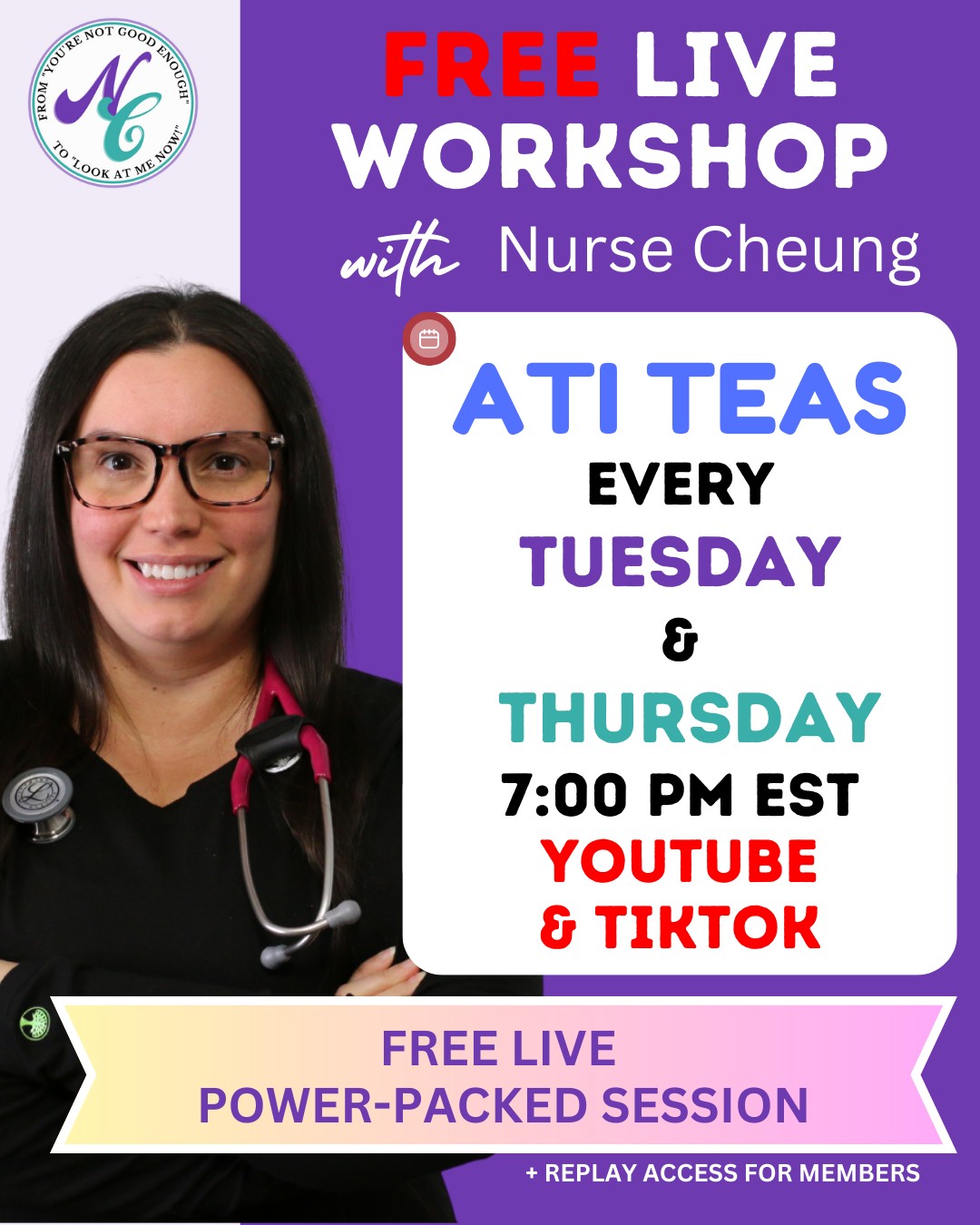If you’re planning to take the ATI TEAS Science exam, you’ll need to know a lot about human anatomy and physiology.
This in-depth guide will teach you everything you need to know! We’ll cover all the key topics on the exam, including cells, tissues, and organ systems; skeletal system; muscular system; nervous system; cardiovascular system; respiratory system; urinary system; and digestive system. Let’s get started!
Objectives for Human Anatomy and Physiology
Total scored items on ATI TEAS: 18 questions out of 44
Demonstrate Knowledge of the General Orientation of Human Anatomy
Anatomical Terminology
The ATI TEAS will expect you to be able to identify the position and location of the human body. Common anatomical terminology you may see is
- Cephalic – head
- Cranial- skull
- Facial – face
- Frontal – forehead
- Occipital – base of the skull
- Temporal – temple
- Orbital or ocular – eye
- Otic – ear
- Buccal – cheek
- Nasal – nose
- Oral – mouth
- Mental – chin
- Cervical – neck
- Sternal – breastbone
- Thoracic – chest
- Mammary- breast
- Acromial – shoulder
- Scapular – shoulder blade
- Vertebral – spinal column
- Lumbar – lower back
- Dorsal – back
- Axillary – Armpit
- Brachial – Arm
- Antecubital – front of the elbow
- Olecranal or cubital – back of the elbow
- Antebrachial – forearm
- Carpal – wrist
- Palmar – palm
- Pollex – thumb
- Dorsum – back of the hand
- Manual – hand
- Digital or phalangeal – fingers
- Abdominal – abdomen
- Umbilical – naval
- Coxa – hip
- Sacral – between the hips
- Coccygeal – tailbone
- Gluteal – buttock
- Pelvic – pelvis
- Pubic – pubis
- Perineal – area between anus and external genitals
- Inguinal – groin
- Femoral – thigh
- Patella – front of the knee
- Popliteal – back of the knee
- Crural – shin
- Sural – calf
- Pedal – foot
- Tarsal – ankle
- Digital of phalangeal – toe
- Pedal – foot
- Plantar – sole of the foot
- Calcaneal – heel
- Tarsal – ankle
- Dorsum – top of the foot
- Hallux – the great toe
Anatomical Position and Anatomical Direction
When studying human anatomy, it is important to use a standard anatomical position. This position includes the following:
- Anterior (toward the front) – For example, the kneecap is on the anterior side of the leg.
- Posterior (toward the back) – For example, the shoulder blades are located on the posterior side of the body.
- Superior (toward the head) – For example, the hand is part of the superior extremity.
- Inferior (toward the feet) – For example, the foot is part of the inferior extremity.
- Medial (toward the midline) – For example, the chest is medial to the arm.
- Lateral (away from the midline) – For example, the little toe is lateral to the big toe on the same foot.
- Proximal (closer to the trunk of the body) – For example, the proximal end of the femur joins the pelvic bone.
- Distal (farther from the trunk of the body) – For example, the hand is distal to the shoulder.
You will also need to be familiar with common directional terms, such as:
- A sagittal plane or median is a vertical plane that divides the body into right and left halves.
- A frontal plane or coronal is a vertical plane that divides the body into anterior (front) and posterior (back) halves.
- A transverse plane or cross-section is a horizontal plane that divides the body into superior (upper) and inferior (lower) halves.
Describe the Anatomy and Physiology of the Respiratory Systems
Structure of the Respiratory System
The respiratory system is responsible for taking in oxygen from the environment and releasing carbon dioxide. The structure of the respiratory system includes the nose, mouth, throat, larynx, trachea, bronchi, and lungs.
- The nose is the external opening of the respiratory system.
- The nostrils lead into the nasal cavity, which is divided into two sections by the septum.
- The mouth and throat are also part of the respiratory system.
- The throat, or pharynx, is a tube that starts behind the nose and goes down to the esophagus.
- The larynx, or voice box, is located at the top of the trachea.
- The trachea, or windpipe, is a tube that goes from the larynx to the bronchi.
- The bronchi are the two main tubes that lead from the trachea to the lungs.
- The bronchioles are the smaller tubes that branch off from the bronchi and lead to the alveoli.
- The alveoli are tiny sacs where gas exchange takes place. These are small, single-cell structures that group together in clusters like grapes.
- The right lung is divided into three sections, while the left lung is divided into two sections. The left lung allows for more space to house the heart.
The Function of the Respiratory System
The respiratory system is responsible for taking in oxygen and releasing carbon dioxide.
When you breathe in, or inhale, your diaphragm contracts and moves downward. This increases the volume of your thoracic cavity and decreases the pressure inside of it. Oxygen is pulled in from the atmospheric air as well as other elements. Oxygen passes from the alveoli into the blood.
As a result, air flows into your lungs.
When you breathe out, or exhale, your diaphragm relaxes and moves upward. This decreases the volume of your thoracic cavity and increases the pressure inside of it. Carbon dioxide is released from the alveoli into the lungs also known as ventilation.
As a result, air flows out of your lungs.
The respiratory system is also responsible for maintaining the pH of the blood.
When the blood becomes too acidic, the respiratory system kicks in to remove the excess acid.
This is done by blowing off carbon dioxide, which is an acidic gas.
Factors that Affect the Respiratory System
There are a number of factors that can affect the respiratory system.
Diseases, such as pneumonia, bronchitis, and asthma, can all cause problems with breathing. Asthma is a common condition that causes the airways to narrow. Mucus buildup can occur making it difficult to inhale and exhale.
Smoking cigarettes is also a major factor that can damage the respiratory system.
Cigarette smoke contains a number of harmful chemicals that can damage the lungs and airways.
Other factors, such as pollution and dust, can also affect the respiratory system.
When the air quality is poor, it can irritate the lungs and cause problems with breathing.
Allergies and inflammation can also play a role in the respiratory system. If you have allergies, your airways may be inflamed, which can make it difficult to breathe. People may experience shortness of breath, wheezing, and difficulty breathing.
Describe the Anatomy and Physiology of the Cardiovascular Systems
Structure of the Cardiovascular System
The cardiovascular system is made up of the heart, blood vessels, and blood.
The heart is a muscular organ that pumps blood throughout the body.
- The heart has four chambers: the right atrium, left atrium, right ventricle, and left ventricle.
- The right atrium and left ventricle are on the right side of the heart, while the left atrium and right ventricle are on the left side.
- The septum is a wall that separates the right and left sides of the heart.
The blood vessels are the tubes that carry blood throughout the body.
There are three major types of blood vessels: arteries, veins, and capillaries.
- Arteries carry oxygen-rich (oxygenated) blood away from the heart, while veins carry oxygen-poor (deoxygenated) blood back to the heart.
- Capillaries are tiny blood vessels that connect the arteries and veins.
- Blood is a liquid that carries oxygen and nutrients to the cells of the body and carbon dioxide and wastes away from the cells.
The heart undergoes two cycles of contractions: the systole and the diastole.
- The systole is the contraction of the heart, while the diastole is the relaxation of the heart.
- During the systole, blood is pumped out of the heart and into the arteries. The atrioventricular (mitral and tricuspid) valves close causing the “lub” sound.
- During the diastole, blood flows into the heart and fills the chambers. The semilunar (aortic and pulmonic) valves cause the “dub” sound.
The heart has its own electrical system that controls the heart rate.
The sinoatrial (SA) node is the pacemaker of the heart and sets the pace for the heart rate.
The electrical signal then travels through the atrioventricular (AV) node, bundle of His, and Purkinje fibers to the ventricles.
This causes the ventricles to contract and pump blood out of the heart.
Blood Flow Through the Cardiovascular System
The cardiovascular system is a closed system, meaning that the blood stays in the vessels and does not leak out under normal conditions.
The heart pumps oxygenated blood through the arteries from the lungs > left atrium > left ventricle > aorta of the body away from the heart.
The blood then flows through the capillaries, where oxygen and nutrients are exchanged in the tissues for carbon dioxide and wastes.
The carbon dioxide, wastes, and oxygen-poor (deoxygenated) blood are then transported through the veins back to the heart. The blood enters through the right atrium > right ventricle > lungs. Where the carbon dioxide is released for oxygen and the entire process starts over.
Functions of the Cardiovascular System
The cardiovascular system is responsible for delivering oxygen and nutrients to the cells of the body and removing carbon dioxide and wastes.
- The heart pumps blood through the arteries to the cells of the body.
- Oxygen and nutrients are delivered to the cells, and carbon dioxide and wastes are removed.
The cardiovascular system is also responsible for maintaining the body’s blood pressure.
- Blood pressure is the force of the blood against the walls of the arteries.
- If the blood pressure is too high, it can damage the arteries.
- If the blood pressure is too low, it can cause problems with blood flow.
The cardiovascular system also helps to regulate the body’s temperature.
- When the body temperature rises, the blood vessels dilate (widen) to allow heat to escape from the body.
- When the body temperature drops, the blood vessels constrict (narrow) to prevent heat from escaping from the body.
The cardiovascular system is also responsible for maintaining the body’s pH.
- A bicarbonate buffer system helps maintain acid by removing excess hydrogen ions from the blood.
The cardiovascular system is responsible for a variety of other functions, including:
- Transporting hormones around the body
- Helping to fight infections
- Aiding in the digestion of food
- Assisting in the repair of damaged tissue
Describe the Anatomy and Physiology of the Digestive System
Structure of the Digestive System
The digestive system is composed of the gastrointestinal (GI) tract and accessory organs.
The GI tract is a long, continuous tube that starts at the mouth and ends at the anus.
The GI tract is divided into the following parts: The mouth, esophagus, stomach, small intestine, large intestine, and rectum.
- Digestion begins in the mouth where you chew and mechanical digestion (physical breakdown) of food occurs. Mucus in saliva lubricates the food and enzymes such as amylase and lipase initiate the chemical digestion of starches and lipids.
- A bolus of food is swallowed and travels through the pharynx into the esophagus.
- Peristalsis (contractions of muscles) occurs in the esophagus to move the food into the stomach.
- The stomach is a J-shaped sac that stores food, initiates chemical digestion with enzymes, and mixes the food.
- Gastric acid kills bacteria, denatures proteins, and activates digestive enzymes.
- The small intestine is the main site of digestion and absorption. It is composed of the duodenum, jejunum, and ileum.
- The small intestine is coiled and has a series of foldings that increase the surface area for absorption.
- The large intestine is composed of the cecum, colon, and rectum.
- The large intestine absorbs water, electrolytes, and vitamins produced by enteric bacteria.
- The rectum is the final section of the GI tract and stores feces until they are eliminated through defecation.
The accessory organs include the teeth, tongue, salivary glands, liver, gallbladder, and pancreas.
These organs help to break down food into smaller pieces so that the body can absorb the nutrients.
Enzyme and Hormones Involved in Digestion
There are several hormones involved in the digestive process, including:
- Gastrin: This hormone is produced by the stomach and stimulates the production of stomach acid.
- Cholecystokinin (CCK): This hormone is produced by the small intestine and stimulates the release of enzymes from the pancreas and bile from the liver.
- Secretin: This hormone is produced by the small intestine and stimulates the production of bicarbonate by the pancreas.
- Insulin: This hormone is produced by the pancreas and helps to regulate blood sugar levels.
- Glucagon: This hormone is produced by the pancreas and helps to release glucose from the liver.
- Bile: This fluid is produced by the liver and stored in the gallbladder. Bile breaks down fats in the small intestine.
Describe the Anatomy and Physiology of the Nervous System
Divisions of the Nervous System
The nervous system can be divided into the central nervous system (CNS) and the peripheral nervous system (PNS).
- The CNS is composed of the brain and the spinal cord. This is the central command center where all communication and actions occur in the body.
- The PNS is composed of the nerves that branch off from the spinal cord and innervate the body. This system sends the signals by the brain to the targeted locations.
- The nervous system is responsible for transmitting signals between the body and the brain.
Structure of the Neuron
The basic unit of the nervous system is the neuron. Neurons are composed of the cell body, dendrites, and an axon.
- The cell body contains the nucleus and other organelles.
- Dendrites are short, branch-like extensions that generated graded electrical impulses.
- The axon is a long extension that transmits the signals to other neurons.
- At the end of the axon are the terminal buttons which release neurotransmitters called the axon terminal.
- Myelin sheath is a white, fatty substance that covers the axon and helps to increase the speed of nerve impulses.
- Synapse is the space between the terminal buttons of one neuron and the dendrites of another neuron.
The Function of the Neuron
The nervous system is responsible for transmitting signals between the body and the brain. These signals can be in the form of electrical impulses or chemical signals.
The electrical impulses are generated by the movement of ions across the cell membrane. This action potential is then transmitted down the axon to the terminal buttons.
The chemical signals are transmitted by the release of neurotransmitters from the terminal buttons. These neurotransmitters bind to receptors on the dendrites of the next neuron and generate an electrical impulse.
This process allows for communication between different parts of the body and the brain.
The nervous system is responsible for transmitting signals between the body and the brain.
Sensory (afferent) neurons send messages to the central nervous system. Motor (efferent) neurons send messages to muscles and can be further divided into the autonomic (involuntary) and somatic (voluntary) nervous systems.
- The autonomic nervous system is responsible for involuntary actions such as heart rate, digestion, and respiration.
- The somatic nervous system is responsible for voluntary actions such as the movement of the limbs.
Describe the Anatomy and Physiology of the Muscular System
Types of Muscle Tissues
There are three types of muscle tissues in the body: skeletal, cardiac, and smooth.
- Skeletal muscle is attached to bones and is responsible for the movement of the body. These muscles are striated and very strong. This muscle is the only voluntary tissue in the body.
- Cardiac muscle is found in the heart and pumps blood throughout the body. These muscles are also striated. Cardiac muscle tissue cannot be consciously controlled making the muscle involuntary.
- Smooth muscle is found in the walls of internal organs such as the stomach, intestines, and blood vessels. These muscles are not striated and involuntary as they cannot be controlled consciously. These muscles are the weakest of all off muscle tissues.
The Function of Muscle Tissues
Muscles are responsible for the movement of the body. They generate force by contracting and produce movement by moving the bones to which they are attached. There are over 700 named muscles in the body and makeup approximately half of the total body weight.
Nerves Control Muscles In the Nervous System
Nerves control muscles by sending electrical impulses to the muscle. These impulses cause the muscle to contract and generate force. The nerve impulse originates in the brain and is sent through the spinal cord to the muscle.
The message is then sent down the axon of the nerve to the muscle. The muscle fibers receive the message and contract.
Describe the Anatomy and Physiology of the Male and Female Reproductive Systems
Structures of Male Reproductive System
The male reproductive system is made up of the testes, epididymis, vas deferens, seminal vesicles, prostate gland, and penis.
- The testes are a pair of oval-shaped organs that produce sperm and testosterone.
- The epididymis is a long, coiled tube that stores and transports sperm.
- The vas deferens is a long, thin tube that carries sperm from the epididymis to the seminal vesicles.
- The seminal vesicles are a pair of sac-like structures that produce a fluid that nourishes the sperm.
- The prostate gland is a small, round organ that produces a fluid that helps to transport the sperm.
- The penis is a long, cylindrical organ that carries urine and sperm out of the body.
Structures of Female Reproductive System
The female reproductive system is made up of the ovaries, fallopian tubes, uterus, vagina, and vulva.
- The ovaries are a pair of small, oval-shaped organs that produce eggs and hormones.
- The fallopian tubes are a pair of long, thin tubes that carry eggs from the ovaries to the uterus.
- The uterus is a pear-shaped organ that houses and protects a developing fetus.
- The vagina is a long, cylindrical organ that carries blood and mucosal tissue from the uterus during a women’s monthly period; provides a passageway for intercourse and sperm until it is distributed to the uterus; and also allows passage for vaginal childbirth.
- The vulva is the external female genitalia that includes the labia, clitoris, and urethra.
Relationship between the Reproductive System and Endocrine System
There are various hormones that are part of the endocrine system that help control processes in the reproductive system. These include gonadotropin-releasing hormone, follicle-stimulating hormone, luteinizing hormone, testosterone, and estrogen.
- Gonadotropin-releasing hormone is produced in the hypothalamus and stimulates the release of follicle-stimulating hormone and luteinizing hormone from the pituitary gland.
- The follicle-stimulating hormone helps to stimulate the growth of eggs in the ovaries and control the menstrual cycle.
- Luteinizing hormone helps to trigger ovulation, the release of an egg from the ovary.
- Testosterone is a hormone produced by the testes that help to produce sperm and develop male characteristics. Unlike in females, sperm is not cyclical like eggs and are constantly produced and matured.
- Estrogen is a hormone produced by the ovaries that helps to develop female characteristics and regulates the menstrual cycle.
In the female reproductive system, the FSH signals the ovaries to produce more estrogen. Estrogen causes an egg to mature. LH is released causing the egg to produce progesterone to prepare the endometrium for implantation. The egg is then released from the ovary and travels down the fallopian tube to the uterus. If the egg is fertilized by a sperm, it will implant in the uterus and begin to grow. If the egg is not fertilized, it will be shed during menstruation.
Describe the Anatomy and Physiology of the Integumentary
Structure of the Integumentary System
The integumentary system is made up of the skin, hair, nails, and sweat glands.
The skin is the largest organ in the body and is made up of three layers: the epidermis, dermis, and subcutaneous / hypodermis.
- The epidermis is the outermost layer of skin that provides a waterproof barrier and protects the body from infection.
- The dermis is the middle layer of skin that contains blood vessels, nerves, hair follicles, and sweat glands.
- The subcutaneous / hypodermis is the innermost layer of skin that consists of fat and connective tissue.
Functions of Integumentary System
The integumentary system has several functions, including protection, regulation of body temperature, and sensation.
Protection: The skin protects the body from harmful substances, UV rays, and excessive water loss by creating a barrier from outside pathogens. Melanocytes produce melanin that helps protect against ultraviolet radiation.
Excretion: The sweat glands help to regulate body temperature by producing sweat that evaporates and cools the body. Sweat contains trace amounts of lactic acid, urea, and alcohol.
Sensation: The skin is packed with nerve endings that allow us to feel touch, pressure, heat, and cold.
Homeostasis and the Integumentary System
The integumentary system helps to maintain homeostasis by regulating body temperature and fluid balance.
When the body becomes too warm, the blood vessels in the skin dilate and sweat is produced to cool the body.
If the body becomes too cold, the blood vessels constrict and the body produces less sweat to maintain heat.
Describe the Anatomy and Physiology of the Endocrine System
Glands of the Endocrine System
The endocrine system is made up of a network of glands that produce and secrete hormones. These hormones help to regulate many body functions, including growth and development, metabolism, reproduction, and mood.
The pituitary gland is the master gland of the endocrine system and produces growth hormone, prolactin, and adrenocorticotropic hormone.
The thyroid gland produces thyroxine and calcitonin. Thyroxine helps to regulate metabolism, while calcitonin helps to regulate calcium levels in the blood.
The parathyroid gland produces parathyroid hormone, which helps to regulate calcium levels in the blood.
The thymus gland produces thymosin, which helps to develop the immune system.
The adrenal gland produces epinephrine and norepinephrine, which help to regulate the fight-or-flight response.
The pancreas produces insulin and glucagon, which help to regulate blood sugar levels.
The ovaries produce estrogen and progesterone, which help to regulate the menstrual cycle.
The testes produce testosterone, which helps to regulate the development of male reproductive organs and secondary sex characteristics.
Functions of the Endocrine System
The endocrine system regulates many body functions, including growth and development, metabolism, reproduction, and mood.
Growth and Development: Hormones play a role in regulating growth and development. For example, growth hormone helps to stimulate cell division and bone growth.
Metabolism: Hormones play a role in regulating metabolism. For example, insulin helps to regulate blood sugar levels.
Reproduction: Hormones play a role in reproduction. For example, estrogen and progesterone help to regulate the menstrual cycle.
Mood: Hormones play a role in mood. For example, norepinephrine and epinephrine help to regulate the fight-or-flight response.
Many hormones from the endocrine glands have different chemical structures including lipid-based hormones; nonpolar, fat-soluble hormones; and water-soluble hormones.
Lipid-based hormones are made of cholesterol and include testosterone and estrogen. These hormones are insoluble in water and are transported in the blood by carrier proteins.
Nonpolar, fat-soluble hormones are made of amino acids and include thyroid hormones. These hormones are insoluble in water and are transported in the blood by carrier proteins.
Water-soluble hormones are made of amino acids and include epinephrine. These hormones are soluble in water and are transported in the blood by diffusion.
Homeostasis and the Endocrine System
The endocrine system helps to maintain homeostasis by regulating growth and development, metabolism, reproduction, and mood.
For example, the endocrine system regulates growth and development by producing hormones that stimulate cell division and bone growth.
The endocrine system also regulates metabolism by producing hormones that help to regulate blood sugar levels.
In addition, the endocrine system regulates reproduction by producing hormones that help to regulate the menstrual cycle.
Finally, the endocrine system regulates mood by producing hormones that help to regulate the fight-or-flight response.
Positive and Negative Feedback Mechanisms
The endocrine system uses positive and negative feedback mechanisms to maintain homeostasis.
A positive feedback mechanism is a process that amplifies the change in a given direction.
For example, the release of oxytocin during childbirth is a positive feedback mechanism that amplifies the change in the given direction of childbirth. Oxytocin stimulates uterine contractions that cause the fetus to push against and stretch the cervix.
A negative feedback mechanism is a process that reverses the change or slows it down.
For example, the release of insulin in response to high blood sugar levels is a negative feedback mechanism that reverses the change or slows it down by lowering blood sugar levels. The pancreas is able to adjust the amount of hormone to secrete in proportion to the amount of blood glucose detected in the blood.
Describe the Anatomy and Physiology of the Urinary System
Structure of the Urinary System
The urinary system is made up of the kidneys, renal cortex, renal medulla, ureters, bladder, and urethra.
The kidneys are a pair of organs that filter blood and produce urine.
The renal cortex is the outer layer of the kidney that contains the renal pyramids and blood vessels. Erythropoietin is stimulated in the production of new red blood cells.
The renal medulla is the inner layer of the kidney that help to concentrate urine.
The ureters are a pair of tubes that carry urine from the kidneys to the bladder.
The bladder is a sac that stores urine until it is ready to be excreted.
The urethra is a tube that carries urine from the bladder to the outside of the body.
Function of the Urinary System
The urinary system is an integral part of homeostasis in the body. This system helps excrete waste and maintain balance.
The structural unit of the kidney is called the nephron. Nephrons are responsible for the filtration of blood by removing waste and reabsorbing water and molecules.
The glomerulus is a ball of capillaries that is the site of filtration in the nephron.
The tubule is a tube that leads from the glomerulus to the renal pelvis. The tubule is responsible for reabsorption and secretion.
What remains from the tubule is then carried into the kidney and drained from the ureter.
Relationship between the Cardiovascular System and Urinary System
The cardiovascular system and urinary system work together to maintain homeostasis in the body.
The cardiovascular system transports blood to the kidneys so that they can filter it.
The urinary system excretes waste and helps to regulate blood pressure by controlling the volume of blood.
In turn, the kidneys produce a hormone called erythropoietin that stimulates the production of new red blood cells in the cardiovascular system.
Describe the Anatomy and Physiology of the Immune System
Parts of the Immune System
The immune system is made up of innate defense and adaptive defense systems.
The innate defense system is the body’s first line of defense against infection and includes physical barriers, such as skin and mucous membranes, as well as chemical barriers, such as enzymes and stomach acid.
The adaptive defense system is the body’s second line of defense and includes the lymphatic system, white blood cells, and antibodies.
Function of the Immune System
The immune system protects the body from foreign invaders, such as bacteria, viruses, and fungi.
It does this by recognizing these invaders and producing antibodies to destroy them.
The immune system also helps to remove these invaders from the body and memory T cells help the body to remember these invaders so that they can be destroyed more quickly if they enter the body again.
Innate Immune System
The innate defense system is the body’s first line of defense against infection and includes physical barriers, such as skin and mucous membranes, as well as chemical barriers, such as enzymes and stomach acid.
One of the first responses is called the inflammatory response. This is when blood vessels dilate and white blood cells and fluids are sent to the area of infection.
Histamines are released causing an increase in blood flow to the area and the number of white blood cells called phagocytes. These phagocytes destroy the unknown bacteria.
This response helps to remove the foreign invader and to begin the healing process.
Adaptive Immune System
The adaptive defense system is the body’s second line of defense and includes the lymphatic system, white blood cells, and antibodies. This system functions with the help of antigens, antigen-presenting cells, helper T cells, cytotoxic T cells, cytokines, antibodies and memory cells.
Antigens are foreign invaders that the body had been exposed to, such as bacteria or viruses, that induce an immune response.
Antigen-presenting cells are white blood cells that engulf the foreign invader and present the antigen on its surface.
Helper T cells are a type of white blood cell that helps to activate the other cells of the immune system. The helper T cells induce B cells to secrete a large number of antibodies to bind to the antigen.
Cytotoxic T cells are a type of white blood cell that destroys infected cells.
Cytokines are chemicals that help to regulate the immune response and activate cytotoxic T cells.
Antibodies are proteins that attach to antigens and help to destroy them.
Memory cells are white blood cells that remember a specific foreign invader and help the body to respond more quickly if the invader enters the body again.
Passive vs Active Immunity
There are two types of immunity: passive and active.
Passive immunity is when the body is exposed to antibodies that have been made by another individual, such as when a mother passes antibodies to her child through breast milk.
Active immunity is when the body produces its own antibodies in response to an infection.
Active immunity is usually longer lasting than passive immunity.
Describe the Anatomy and Physiology of the Skeletal System
Structure and Function of the Skeletal System
The skeletal system is made up of bones, which are connected by joints. Bones are held together at the joints by ligaments.
Bones come in four major types: long, short, flat, and irregular.
Long bones are found in the arms and legs including the humerus, femur, ulna radius, tibia, and fibula. They are longer than they are wide and have a shaft with two enlarged ends, called the proximal and distal ends. The shaft of the long bone is called the diaphysis and the enlarged ends are called the epiphyses.
Short bones are found in the wrists and ankles and include the bones of the carpals and tarsals. They are approximately equal in length and width.
Flat bones are found in the ribs, sternum, shoulder blades, and hip bones. They are thin and often curved.
Irregular bones are found in the spine and include the vertebrae. They have a variety of shapes and are not symmetrical.
Bone Composition
Bones are made up of several different types of tissue including compact bone, spongy bone, cancellous bone, and trabecular bone.
Compact bone is the hard outer layer of bone that provides protection and support. It makes up the shaft of long bones and the flat surfaces of other bones.
Spongy bone is a porous, lightweight bone that is found at the ends of long bones and in the vertebrae.
Cancellous bone is a type of spongy bone that contains many small cavities.
Trabecular bone is a type of spongy bone that has a honeycomb-like structure.
Bones are also made up of marrow, which is a soft tissue that produces blood cells.
Brittle bone disease (osteogenesis imperfecta) results from a mutation in the gene that codes for collagen, which is a protein that makes up bone tissue. This disease causes bones to be fragile and break easily.
The Skeletal System and Muscular System
The muscular system provides movement for the skeletal system and they must work together through communication with the nervous system.
The muscle connects to bones with tendons which are comprised of connective tissue. For example, the biceps brachii is a muscle in the upper arm that attaches to the shoulder bone with tendons. The biceps brachii contract to lift the arm.


